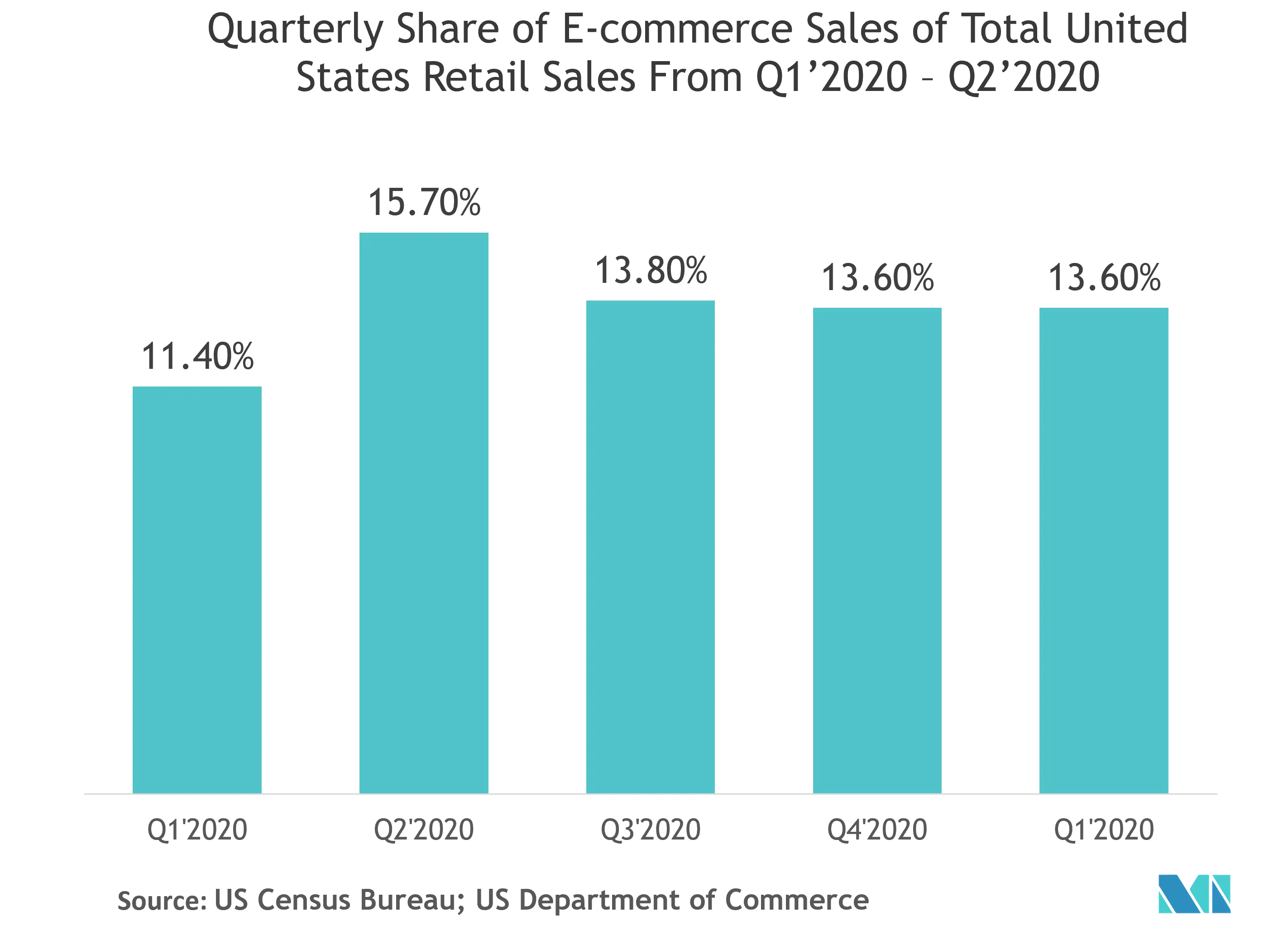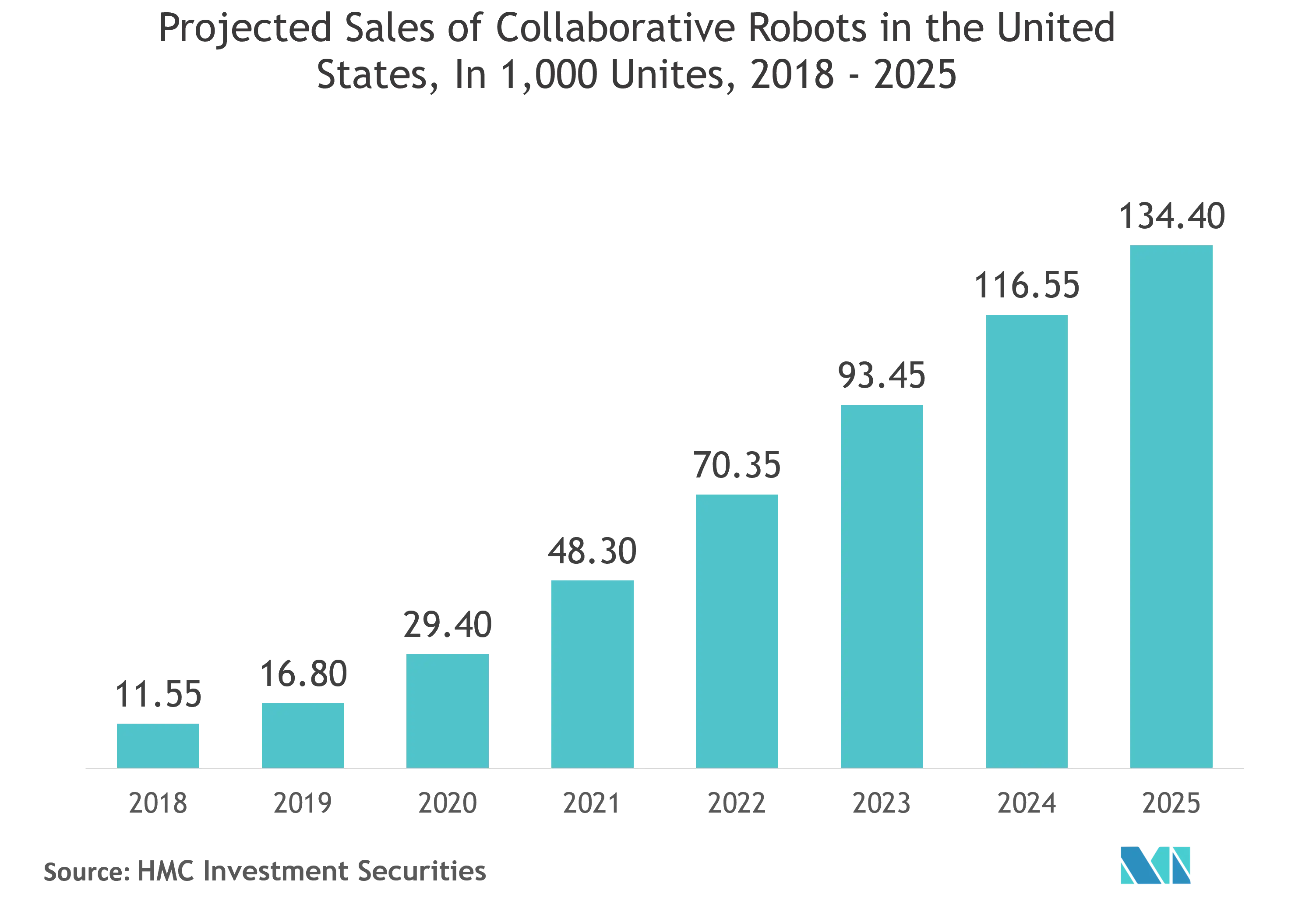Market Trends of North America Collaborative Robots Industry
This section covers the major market trends shaping the North America Collaborative Robots Market according to our research experts:
Material Handling is Expected to Witness Significant Growth
- Material handling is forecast to occupy a majority share of the global collaborative robot market since it is implemented in many end-use industries. For instance, demand for high speed and precision work fulfilled by collaborative robots benefits the electronics and semiconductors industry on a large scale.
- With e-commerce generates the greatest Y-o-Y growth of all retail industries in the United States. More warehousing space is being built in the region than projected warehousing jobs are required to fill that space.
- The trend of online returns has also been accelerated in recent years and is increasing each holiday season, impacting the National Returns Day, which is known as the busiest day for holiday returns in the United States, United Parcel Services estimated handling a record 1.9 million packages on January 2, 2020, a 26% increase over the 2018 post-holiday season. Such trends are highlighting the demand for material handling cobots.
- Technological advancements enhance the capabilities of material handling cobots. Not only are human workers able to work side-by-side with material handling cobots in collaboration, new exoskeleton technologies allow them to be worn by human workers.
- Full-body exoskeletons, designed to lift heavy payloads of up to 200 pounds, are worn by humans to provide additional strength and endurance for repetitive tasks involving heavy tools or components. The exoskeleton is controlled using advanced actuators, sensors, and materials coupled with highly-sophisticated software control algorithms.
- Initially, cobots were typically associated with small payloads and lightweight applications, but they are getting stronger every day, and some are already capable of handling the heavy-duty payloads and applications that were traditionally thought of as being beyond cobot capabilities.
- In March 2020, the Motoman Robotics Division of Yaskawa America Inc. released the new 20-kg payload Model HC20XP collaborative robot with 1700-mm reach. It is the industry’s first IP67-rated collaborative robot, which makes it ideal for a broad range of material-handling, machine-tending or assembly tasks. It can provide continuous use in damp or splash-prone environments. NSF H1 food-grade grease is included as standard, enabling use in settings where there is a possibility of incidental food contact.

United States is Expected to Account for Major Market Share
- The North American region is among the leading innovators and pioneers in terms of the adoption of robotics, as well as one of the largest markets. The primary reason for the growth of the market is the increasing adoption of these collaborative robots across numerous industries.
- Moreover, there has been significant adoption of robotic surgery in the United States. The annual procedure volume for robotic surgery is greater than 5,00,000 in the United States. In order to build brand image and competitive advantage, robotic surgery has become the most rapidly adopted medical device over the past two decades. This is likely to fuel the need for robots in the medical and healthcare sector in the region.
- According to the International Federation of Robotics, in the American region, the growth rate of robots witnessed an increase of 20% compared to the previous year, which marked a new record level for the sixth consecutive year.
- According to HMC Investment Securities, the sales of collaborative robots in the United States will witness significant growth during the forecast period, which is expected to reach 134.40 thousand units in 2025 from 11.55 thousand units in 2018, owing to the widespread of adoption of collaborative robots in various fields, especially in the industrial segment where the Industry 4.0 is gaining transformation in the country for industrial operation and smart factory. The collaborative robots help in increasing productivity and improving utilization by integrating robotics and automation to assist humans.
- The primary driver for the growth of robots in the region is the manufacturing industries in the United States that are currently under the ongoing trend to automate their production processes, in order to strengthen the US industries in both domestic and international markets.
- The government in the region is also encouraging the adoption of robotics by taking initiatives to support the development of modern technologies in the robotics market. For instance, the US Federal Government has commenced a program called the National Robotics Initiative (NRI) to bolster the capabilities of building domestic robots in the country and encourage the research activities in the field.

